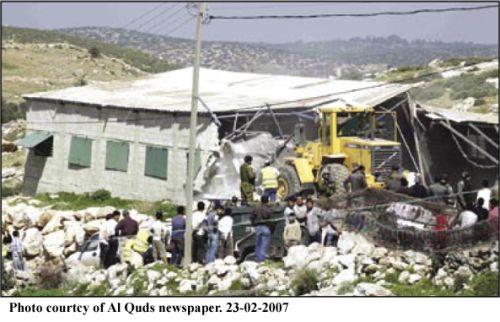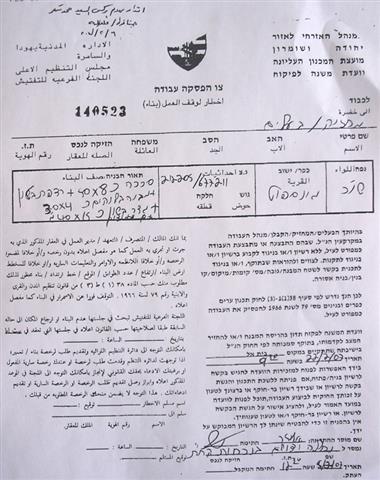Photo 1: Ar Ras quarter- Idhna- Hebron: an Israeli bulldozers demolishing a poultry farm)
One poultry farm and one and sheep farm were demolished at the hands of the Israeli occupation forces on February 22nd, 2007 under the pretext of un-licensing. The two farms are located in Ar Ras quarter in the western part of Idhna town in Hebron governorate.
Mr. Ibrahin Hashim Al Batran, a resident of Ar Ras area told LRC field worker that the demolition acts which were carried out by two bulldozers under strict army protection aimed at his egg- producing chicken farm and at a sheep farm owned by Mr. Mohammed Hussein An Natah. He added that the demolitions have led to the killing of 1000 hens at his 400 square meters farm. He believed that the two farms were quickly demolished because of their close proximity to the path of the Segregation Wall.
Mr. Al Batran estimated his material loss at 80 000 New Israeli Shekels, pointing to the fact that a number of houses and other structures located in the vicinity of his demolished farm were issued demolition orders along with his farm two years ago.
Location, population and area
The village of Idhna is a front line border village located 13 km to the west of Hebron city. It has the population of 20000. The main source of income in the village is agriculture after loosing jobs in Israel at the beginning of the current Intifada in the year 2000. The village's total land area is 21526 dunums of which 2809 dunums are built up area.
Map1: Location of Idhna village
Before 1948, the total area of lands affiliated to the village was about 36 000 dunums. From 1952 to 1972 the Israeli occupation authorities confiscated 14474 dunums from Idhna's most beautiful and fertile lands under the pretext of remarking borders and creating military zones. The aforementioned confiscated lands are all located to the west of the town.
The lost of fertile plateaus and dozens of surface springs to the west of the town after the war of 1948 forced Idhna citizens to move to hilly areas eastward and start cultivating them. Now, the town is famous of olive groves grown in this hilly area.
The Wall � A new tool for land confiscation
About 2000 dunums from Idhna lands have been destroyed under the Wall path or separated behind it as it goes at the average depth of 400 meters and length of 5000 meters inside the Idhna lands. The destruction of the land has led to the uprooting of at least 1500 olive and almond trees, according to the public relations officer at Idhan municipality, Mr. Abdul Rahman Tumaizi.
A threat of eviction campaign
Sources at Idhna municipality cautioned that the recent demolitions could be the beginning of a wider campaign of demolitions and evictions that will target the houses and people who live in that particular area of close proximity to the Wall although they have been living there for many years. During the course of last year a number of demolitions were carried out in the same area.
More notifications and warnings
In related development, the Israeli occupation forces handed over 17 notifications for halting construction of tents and huts by Palestinian shepherd families who settle in the land that has been separated by the Segregation Wall to the west of Idhna and Ad Dahiriya towns in Hebron governorate.
Photos 2, 3 & 4: A sample of copies of ' the halt construction notifications')
The Notifications were distributed at the beginning of this month (see attached copies). 11 of the notifications were given to families from Idhna while the remaining 6 were given to families from Ad Dahiriya. The two family groups have been living for many years in Khirbet Qasa, 15 km to the west of Hebron city which has been separated behind the Wall. The main reason behind the issuance of these notifications is to dismiss these families who total about 230 people and their cattle out of the area as a preliminary step towards the confiscation of their land.
(Photos 5,6 & 7: Khirbet Qasa-Idhna-Hebron : Some of the huts and tents threatened with demolition)
Among the affected families are the following:
1. Izzat Mohammed Abu Sa'don from Idhna;
2. Yusif Abdul Qader An Nattah from Idhna;
3. Aref Mohammed Abu Sa'don from Idhna;
4. Saleh Ahamd An Natah from Idhna;
5. Ahmad Shehda Alweriedat from Ad Dahiriya.
Photo 8: Khirbet Qasa-Idhna-Hebron: A shepherd resident of the area grazing his cattle
Prepared by
The Land Research Center
LRC






















